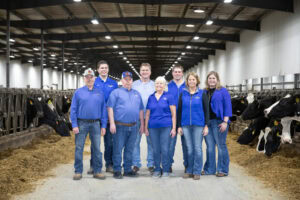Seeing the environmental impact of new sustainability practices encourages Sandy Larson of Larson Acres to keep discovering new conservation practices.
Larson’s family dairy farm milks 2,800 cows and farms more than 5,000 acres in Rock County. They joined the Lafayette Ag Stewardship Alliance in 2019 to participate in a five-year sustainability pilot project offered in partnership with Farmers for Sustainable Food. They have since stayed active with the group to share their sustainability story and learn from other farmers.
Over time, the family continues to incorporate additional sustainable farming practices, including minimal-till and no-till practices to help reduce soil erosion and the use of cover crops to help improve soil health.
“We started seeding cover crops because we wanted to improve the soil erosion in our fields,” Larson said. “We believe this will continue to greatly improve soil health years into the future.”
Being a part of LASA allows Larson to collaborate with like-minded farmers and to continue to learn about the latest conservation research efforts and discoveries.
“Engaging with fellow farmers and having access to these great tools the group provides has been extremely beneficial for our farm’s growth and progress in our sustainability journey,” Larson said. “Working together as a group is the key here; there’s a lot of value in that. We have greater access to new ideas and new strategies.”
Annual Survey Results
As part of their membership, Larson participated in the group’s 2023 Annual Member Conservation Practice Survey, which tracts the collective conservation efforts among farmers in the group. Results demonstrate continued progress and potential environmental benefits to the region.
This is the sixth consecutive year the group has documented their sustainable practices, signifying their commitment to continuous improvement and enhancing the surrounding soil and water quality.
The group, comprised of 35 farmers, implemented various conservation practices including: planting 11,793 acres of cover crops, using no-till and strip-till on 29,022 acres and planting into cover crops (otherwise known as “planting green”) on 1,052 acres. They also measured nutrient management impact on 32,761 acres.
The potential environmental benefits of these practices:
- Reduction of greenhouse gas emissions by 9,018 metric tons of carbon dioxide equivalents, which is equal to greenhouse gas emissions produced by 2,146 cars driven in a year.
- Prevention of sediment loss from farm fields by 87,898 tons, equivalent to 8,789 dump trucks’ worth of soil.
- Reduction of phosphorus runoff by 144,202 pounds, potentially preventing 72.1 million pounds of algae growth in local water bodies.
Data was analyzed and verified by Farmers for Sustainable Food and the Department of Agriculture, Trade and Consumer Protection.
Larson says she uses the data as a resource to help make more informed decisions on the farm.
“Seeing our progress and comparing it to the other farms around us is very eye-opening,” Larson said. “It allows us to make better-informed choices that can help improve our land and local communities.”
Farmers interested in finding out more about the programs LASA offers and how to become a member can visit their website: https://lafayetteagstewardship.org/


